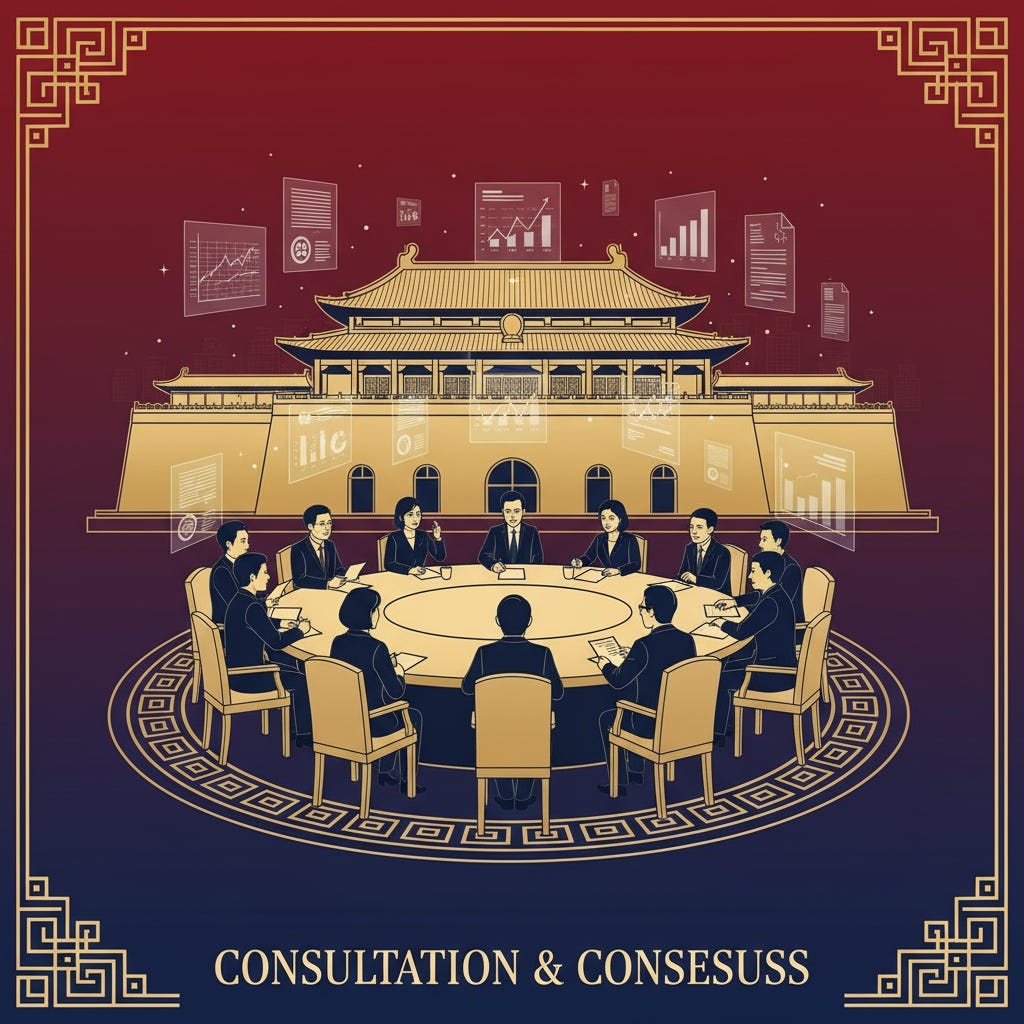Wednesday Edition — How China Builds Agreement Without Competition
How China's government really works
China’s government does not use the adversarial approach, common in Western democracies. Rather than parties pitted against each other with winners and losers, in China’s system, parties cooperate to find the best outcome.
In Western democracies, if a party puts forth a policy, the opposing parties must either oppose it or significantly change it. Supporting a policy from an opposing party is to admit the opposing party is correct and thereby endorse them; this seldom happens.
In China, the different parties do not compete against each other. The goal is not to beat the other parties; it is to cooperate and find the best possible policy. Discussion happens inside controlled channels designed to find alignment before policies are announced.
Two key institutions anchor this process: the Chinese People’s Political Consultative Conference (CPPCC) and the National People's Congress.
The CPPCC is the formal advisory organization to the Chinese Communist Party (CCP). Its main job is to give the eight minor parties and experts in different fields who aren’t part of the Communist Party leadership a voice in policy and politics in general.
The National People’s Congress is China’s national legislature and the highest state institution. Its nearly 3,000 members meet annually to approve laws and Five-Year Plans.
The CPPCC: Structured Consultation
The CPPCC is an advisory body that brings together more than 2,000 representatives from across society: the CCP, the eight non-Communist parties, business leaders, academics, ethnic minorities, and professional associations.
Each year, the CPPCC meets alongside the National People’s Congress. Proposals, reports, and public recommendations are submitted, discussed, and passed upward to Party leaders. While it does not vote on laws, its function is to work out policy recommendations, build support, and identify potential problems before policies are finalized.
This process allows for broad participation while maintaining CCP control. Debate happens inside the system. The intent is to build consensus before decisions reach the national level.
The Party Congress: Consensus Through Unity
Every five years, the National Party Congress gathers nearly 2,300 delegates from all provinces and sectors. It reviews the Party’s achievements, adjusts long-term plans, and selects the Central Committee, which then elects the Politburo and its Standing Committee.
This is where new leaders are formally confirmed. But it is not an election in the democratic sense. Candidates are vetted through years of internal evaluation (see Tuesday Edition on meritocracy), and outcomes are decided before the Congress begins.
The Congress communicates unity and continuity. By confirming leadership through ceremony and consensus, the Party reinforces stability, the highest political value in China’s model.
Cultural Logic of Consultation
China’s consultative institutions reflect three key cultural traits:
High Power Distance, in which power is centralized at the top, and those who hold it are expected to make competent, results-based decisions. The Party defines strategy; lower representatives refine it within set boundaries. The system values order and predictability.
Communitarianism prioritizes the group over the individual. The CPPCC collects input from industry, academia, and community organizations to align social goals with national priorities. The People’s and Party Congresses consolidate those views into common objectives, ensuring decisions reflect collective agreement rather than personal ambition.
Harmony keeps the process stable. Disagreements are resolved through internal discussion instead of public debate. The CPPCC refines proposals, the People’s Congress turns them into law, and the Party Congress confirms continuity and direction.
Hornby’s Archetypes and Consultation
Hornby’s archetypes explain the behavior that underlies China’s consultative process.
The East (Communicator) archetype guides how information moves. It emphasizes explanation, coordination, and teaching instead of competition. The CPPCC reflects this pattern: members present ideas, test interpretations, and align viewpoints before policies are finalized.
The Blue (Guardian) archetype sets the boundaries. It represents order, duty, and adherence to rules. In China’s consultation system, this trait keeps discussions focused on stability and Party priorities rather than individual persuasion.
The Green (Caregiver) archetype gives consultation its social dimension. It focuses on social awareness, listening to concerns from regions, professions, and minority groups. The goal is to maintain inclusion.
The East organizes communication, the Blue enforces order, and the Green balances social needs.
Consensus vs. Competition
In democracies, leadership and policy change often through elections. In China, stability comes from coordination and results. Consultation is designed to align goals and prevent disruption. People and organizations present opinions, but they do not compete for control.
This method creates predictability. The CPPCC and Party Congress absorb disagreement, refine it, and pass forward unified outcomes. The process removes political shocks that could interrupt long-term planning in the economy or social programs.
To outsiders, it can appear rigid; to supporters, it ensures order and continuity. Both views describe the same design, a controlled system built to keep policy steady and government performance consistent over time.
Why It Matters
China’s system of consultation shows that the government does not require open conflict, competition, or personality-driven campaigns. It runs on organized discussion instead of competition. The CPPCC and the Party Congress collect opinions, gather feedback, and settle disagreements before they turn into problems. This system reflects China’s focus on order, cooperation, and lasting stability.
There is more cultural perspective on TikTok and YouTube





